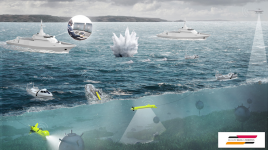Some updates on the MCDV's. As they have now are starting to reach the end of their design life the RCN is working on life extensions. No surprise here, it's literally in
LEADMARK 2050 that this was the goal.
More importantly, there is a discussion on standing up a replacement OPV project within the next few years (it's all watercooler stuff right now). That would likely be to do some sort of options analysis, requirements analysis, lessons learned etc...
Now I'm not sure where that sort of analysis would end up. LEADMARK lists Mine Countermeasures as an important task for the class and that retention of that capability within the RCN is important. It also points out how valuable the MCDV's have been on peace support and security missions from Africa to the Mexican west coast. There is also the discussion that any such replacement vessel would need to complement the AOPS.
However, the RCN really hasn't invested into MCM heavily like say the Belgians or Swedes have. We don't embarrass ourselves but it's not what I would call a strong capability outside of the Clearance diver trade. It's not like the Kingston class is a specialized MCM vessel. It's basically just a maneuverable hull that you slap equipment on.
Now the fun. A replacement (
@Colin Parkinson get in here, you love this stuff...)
Given the two mission sets inherent to the Kingston Class there are two general ways to go. A single class replacement or two class replacement.
6-8 ships to replace 12, as the AOPS will be doing some of the security missions.
Looking at some of the options out there the
MCMV that the Belgians/Dutch are looking to use seems like quite the package. It is however listed at ~2800 tons and ~82m in length. It's a much more substantial ship than the MCDV, but with that likely comes better seakeeping and legs. What I like about it that those large MCM vehicle launch bays could also carry boats for security missions. It has a cruise speed of 15 knots.
One of the things that stand out with this ship is that its a package of systems. Without all the other systems (or ones like it) its not nearly as effective. If the RCN wants to take MCM seriously this is the type of direction they should head.
If OPV is the goal then River Class stands out to me. It's literally designed for the Northern Latitudes. It's twice the size of an MCDV but goes about twice as fast as well. The fact it can take ISO containers makes it flexible for some of the interesting trials that MCDV's do. Also it would be a good platform for the
TRAPS to add some ASW capabilities to an OPV. Using a similar ISO container capability to makeover the ship to be an MCM platform could be done but it doesn't have the station-keeping abilities likely needed of a proper MCM (with thrusters etc...).


